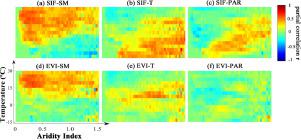当前位置:
X-MOL 学术
›
Agric. For. Meteorol.
›
论文详情
Our official English website, www.x-mol.net, welcomes your
feedback! (Note: you will need to create a separate account there.)
Global climatic controls on interannual variability of ecosystem productivity: Similarities and differences inferred from solar-induced chlorophyll fluorescence and enhanced vegetation index
Agricultural and Forest Meteorology ( IF 5.6 ) Pub Date : 2020-07-01 , DOI: 10.1016/j.agrformet.2020.108018 Xing Li , Jingfeng Xiao
Agricultural and Forest Meteorology ( IF 5.6 ) Pub Date : 2020-07-01 , DOI: 10.1016/j.agrformet.2020.108018 Xing Li , Jingfeng Xiao

|
Abstract Assessing how climate factors regulate the interannual variability (IAV) of ecosystem productivity globally is crucial for understanding the ecosystem-climate interactions and carbon-climate feedbacks under a changing climate. However, our understanding of global climatic controls on the IAV of ecosystem productivity has been limited by the lack of direct measurements of ecosystem productivity at the global scale. We used a long-term, fine-resolution solar-induced chlorophyll fluorescence (SIF) product (GOSIF) derived from SIF soundings measured by the Orbiting Carbon Observatory-2 (OCO-2) to investigate how climatic factors drive the IAV of global ecosystem productivity. We also examined how the results derived from SIF differed from those based on a satellite-derived measure of vegetation greenness and productivity - the enhanced vegetation index (EVI) derived from the Moderate Resolution Imaging Spectroradiometer (MODIS). Both productivity measures showed the dominant role of soil moisture in driving the IAV of global ecosystem productivity, particularly in arid and semi-arid areas. SIF was more sensitive to climate variability than was EVI. SIF was positively correlated with solar radiation in the humid regions, while no significant correlations were found between EVI and solar radiation. The stronger correlation of SIF with climate factors was also observed at the ecosystem level based on a number of eddy covariance flux sites, indicating that SIF had a higher ability in capturing the variations of gross primary productivity (GPP) than did EVI. The comparison between SIF and EVI also highlighted the biome-specific (depending on the tree cover) responses of ecosystem productivity to solar radiation under water stress. Our findings explicitly reveal the global climatic controls on the IAV of ecosystem productivity, and provide insight into the mechanistic differences between SIF and vegetation indices in characterizing ecosystem productivity.
中文翻译:

对生态系统生产力年际变化的全球气候控制:从太阳诱导的叶绿素荧光和增强的植被指数推断的异同
摘要 评估气候因素如何调节全球生态系统生产力的年际变化(IAV)对于理解气候变化下的生态系统-气候相互作用和碳-气候反馈至关重要。然而,由于缺乏对全球范围内生态系统生产力的直接测量,我们对全球气候控制对生态系统生产力 IAV 的理解受到限制。我们使用来自轨道碳观测站 2 (OCO-2) 测量的 SIF 探测的长期、高分辨率太阳诱导叶绿素荧光 (SIF) 产品 (GOSIF) 来研究气候因素如何驱动全球生态系统的 IAV生产率。我们还研究了 SIF 得出的结果与基于卫星得出的植被绿度和生产力测量结果的不同之处 - 中分辨率成像光谱仪 (MODIS) 得出的增强植被指数 (EVI)。两种生产力措施都表明土壤水分在推动全球生态系统生产力的 IAV 中起主导作用,特别是在干旱和半干旱地区。SIF 对气候变率比 EVI 更敏感。SIF与潮湿地区的太阳辐射呈正相关,而EVI与太阳辐射之间未发现显着相关。基于多个涡度协方差通量站点,在生态系统层面也观察到 SIF 与气候因子的更强相关性,表明 SIF 比 EVI 具有更高的捕捉总初级生产力(GPP)变化的能力。SIF 和 EVI 之间的比较还突出了生态系统生产力在缺水压力下对太阳辐射的特定生物群落(取决于树木覆盖)响应。我们的研究结果明确揭示了全球气候对生态系统生产力 IAV 的控制,并提供了洞察 SIF 和植被指数在表征生态系统生产力方面的机制差异。
更新日期:2020-07-01
中文翻译:

对生态系统生产力年际变化的全球气候控制:从太阳诱导的叶绿素荧光和增强的植被指数推断的异同
摘要 评估气候因素如何调节全球生态系统生产力的年际变化(IAV)对于理解气候变化下的生态系统-气候相互作用和碳-气候反馈至关重要。然而,由于缺乏对全球范围内生态系统生产力的直接测量,我们对全球气候控制对生态系统生产力 IAV 的理解受到限制。我们使用来自轨道碳观测站 2 (OCO-2) 测量的 SIF 探测的长期、高分辨率太阳诱导叶绿素荧光 (SIF) 产品 (GOSIF) 来研究气候因素如何驱动全球生态系统的 IAV生产率。我们还研究了 SIF 得出的结果与基于卫星得出的植被绿度和生产力测量结果的不同之处 - 中分辨率成像光谱仪 (MODIS) 得出的增强植被指数 (EVI)。两种生产力措施都表明土壤水分在推动全球生态系统生产力的 IAV 中起主导作用,特别是在干旱和半干旱地区。SIF 对气候变率比 EVI 更敏感。SIF与潮湿地区的太阳辐射呈正相关,而EVI与太阳辐射之间未发现显着相关。基于多个涡度协方差通量站点,在生态系统层面也观察到 SIF 与气候因子的更强相关性,表明 SIF 比 EVI 具有更高的捕捉总初级生产力(GPP)变化的能力。SIF 和 EVI 之间的比较还突出了生态系统生产力在缺水压力下对太阳辐射的特定生物群落(取决于树木覆盖)响应。我们的研究结果明确揭示了全球气候对生态系统生产力 IAV 的控制,并提供了洞察 SIF 和植被指数在表征生态系统生产力方面的机制差异。










































 京公网安备 11010802027423号
京公网安备 11010802027423号